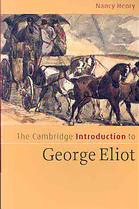
The Cambridge introduction to George Eliot PDF
Preview The Cambridge introduction to George Eliot
This page intentionally left blank TheCambridgeIntroductionto George Eliot AstheauthorofTheMillontheFlossandMiddlemarch,GeorgeEliot wasoneofthemostadmirednovelistsoftheVictorianperiod,andshe remainsacentralfigureintheliterarycanontoday.Shewasthefirst womantowritethekindofpoliticalandphilosophicalfictionthathad previouslybeenamalepreserve,combiningrigorousintellectualideas withasensitiveunderstandingofhumanrelationshipsandmakingher oneofthemostimportantwritersofthenineteenthcentury.This innovativeintroductionprovidesstudentswiththereligious,political, scientificandculturalcontextsthattheyneedtounderstandand appreciatehernovels,stories,poetryandcriticalessays.NancyHenry alsotracesthereceptionofherworktothepresent,surveyingarangeof criticalandtheoreticalresponses.Eachnovelisdiscussedinaseparate section,makingthisthemostcomprehensiveshortintroduction availabletothisimportantauthor. NancyHenryisAssociateProfessorofEnglishattheStateUniversityof NewYorkatBinghamton.Sheistheauthorof,amongotherbooks, GeorgeEliotandth eBritishEmpire(Cambridge,2002;paperback edition,2006). Cambridge Introductions to Literature Thisseriesisdesignedtointroducestudentstokeytopicsandauthors.Accessibleand lively,theseintroductionswillalsoappealtoreaderswhowanttobroadentheir understandingofthebooksandauthorstheyenjoy. (cid:1) Idealforstudents,teachers,andlecturers (cid:1) Concise,yetpackedwithessentialinformation (cid:1) Keysuggestionsforfurtherreading Titlesinthisseries EricBulson TheCambridgeIntroductiontoJamesJoyce WarrenChernaik TheCambridgeIntroductiontoShakespeare’sHistoryPlays JohnXirosCooper TheCambridgeIntroductiontoT.S.Eliot PatrickCorcoran TheCambridgeIntroductiontoFrancophoneLiterature GreggCrane TheCambridgeIntroductiontoTheNineteenth-CenturyAmericanNovel KirkCurnutt TheCambridgeIntroductiontoF.ScottFitzgerald JanetteDillon TheCambridgeIntroductiontoEarlyEnglishTheatre JanetteDillon TheCambridgeIntroductiontoShakespeare’sTragedies PennyGay TheCambridgeIntroductiontoShakespeare’sComedies JaneGoldman TheCambridgeIntroductiontoVirginiaWoolf KevinJ.Hayes TheCambridgeIntroductiontoHermanMelville NancyHenry TheCambridgeIntroductiontoGeorgeEliot LeslieHill TheCambridgeIntroductiontoJacquesDerrida DavidHoldeman TheCambridgeIntroductiontoW.B.Yeats AdrianHunter TheCambridgeIntroductiontotheShortStoryinEnglish C.L.Innes TheCambridgeIntroductiontoPostcolonialLiteratures M.JimmieKillingsworth TheCambridgeIntroductiontoWaltWhitman PericlesLewis TheCambridgeIntroductiontoModernism RonanMcDonald TheCambridgeIntroductiontoSamuelBeckett WendyMartin TheCambridgeIntroductiontoEmilyDickinson PeterMessent TheCambridgeIntroductiontoMarkTwain DavidMorley TheCambridgeIntroductiontoCreativeWriting IraNadel TheCambridgeIntroductiontoEzraPound LelandS.Person TheCambridgeIntroductiontoNathanielHawthorne JohnPeters TheCambridgeIntroductiontoJosephConrad JustinQuinn TheCambridgeIntroductiontoModernIrishPoetry SarahRobbins TheCambridgeIntroductiontoHarrietBeecherStowe MartinScofield TheCambridgeIntroductiontotheAmericanShortStory EmmaSmith TheCambridgeIntroductiontoShakespeare PeterThomson TheCambridgeIntroductiontoEnglishTheatre,1660–1900 JanetTodd TheCambridgeIntroductiontoJaneAusten TheresaM.Towner TheCambridgeIntroductiontoWilliamFaulkner JenniferWallace TheCambridgeIntroductiontoTragedy The Cambridge Introduction to George Eliot NANCY HENRY CAMBRIDGE UNIVERSITY PRESS Cambridge, New York, Melbourne, Madrid, Cape Town, Singapore, São Paulo Cambridge University Press The Edinburgh Building, Cambridge CB2 8RU, UK Published in the United States of America by Cambridge University Press, New York www.cambridge.org Information on this title: www.cambridge.org/9780521854627 © Nancy Henry 2008 This publication is in copyright. Subject to statutory exception and to the provision of relevant collective licensing agreements, no reproduction of any part may take place without the written permission of Cambridge University Press. First published in print format 2008 ISBN-13 978-0-511-56849-7 eBook (Dawsonera) ISBN-13 978-0-521-85462-7 hardback ISBN-13 978-0-521-67097-5 paperback Cambridge University Press has no responsibility for the persistence or accuracy of urls for external or third-party internet websites referred to in this publication, and does not guarantee that any content on such websites is, or will remain, accurate or appropriate. InMemoriam GeorgeBriteMerchant(1920–2002) NancyBriteMerchantHenry(1929–2003) Bitsy(1988–2005) Contents Preface page viii Acknowledgements x Abbreviations xi Chapter 1 Life 1 Chapter 2 Historical contexts 14 Chapter 3 Literary influences 30 Chapter 4 Works 41 Reviewsandessays 41 ScenesofClericalLife 46 AdamBede 52 TheMillontheFloss 56 SilasMarner,“TheLiftedVeil”and“Brother Jacob” 62 Romola 70 FelixHolt,TheRadical 77 Poetry 83 Middlemarch 88 DanielDeronda 94 ImpressionsofTheophrastusSuch 101 Chapter 5 Afterlife 104 Notes 115 Furtherreading 120 Index 123 vii Preface Two of George Eliot’s fictional heroines fantasize about journeying to see a famous writer. Unhappy Maggie Tulliver in The Mill on the Floss harbors a pathetic dream: “she would go to some great man – Walter Scott, perhaps – and tell him how wretched and how clever she was, and he would surely do somethingforher”(Mill,IV:3).EquallywretchedRomolaleavesherhusband withtheintentionofvisiting“themostlearnedwomanintheworld,Cassandra Fedele,atVenice”toaskheradviceabouthowshecanlearntosupportherself (R,II:36).PerhapsthenarratorofAdamBedeofferstheexplanationforwhy neither Maggie nor Romola realizes her fantasy: “if you would maintain the slightestbeliefinhumanheroism,youmustnevermakeapilgrimagetoseethe hero”(AB,II:17). GeorgeEliot(MarianEvansLewes)wasaliteraryherotomanyduringher lifeandtosubsequentgenerationsofreadersandwriters.Inhistoricalmemory, sheisascompellingandcharismaticafigureasshewasinlife.Herastonishing mindledmenandwomentofallinlovewithherevenbeforeshebegantowrite fiction.Somefellinlovewithherthroughreadingherfiction.Inthefinalyears of her life, many came to pay tribute at the carefully orchestrated afternoon salonsinherLondonhome,thePriory.Afterherdeath,someofthepilgrims becamedisillusioned,a ndherreputationsuffered. Itisnotsurprisingthat150yearssinceshepublishedherfirststory,herfiction too has attracted acolytes and detractors, both with a peculiar intensity that reflectstheambivalentfeelingsofsubsequentgenerationstowardtheVictorian age, which Eliot so powerfully represents. The realism that was praised in the mid nineteenth century for extending sympathy to common, unheroic peoplewasoftencriticizedattheendofthetwentiethcenturyforitsessentially middle-class perspective. Such responses suggest that how we read George Eliot’s writing has everything to do with our own historical context, but to appreciateherworksproperly,weneedtoknowsomethingabouttheircontexts. This book provides an introduction to Eliot’s life, reading and historical milieu,contextsthatareintimatelyrelated:readingwaspartofherlifeandher life is part of history. As her much-admired contemporary Elizabeth Barrett viii
